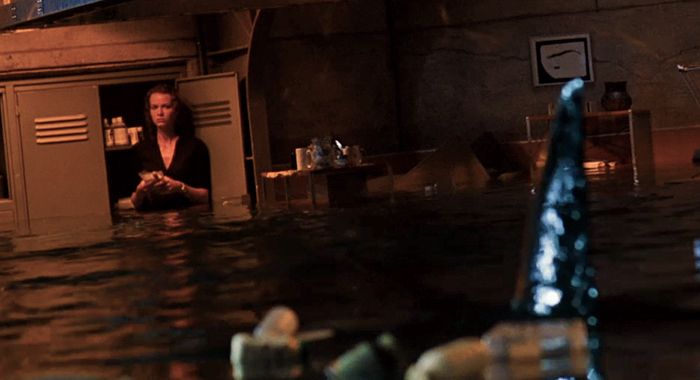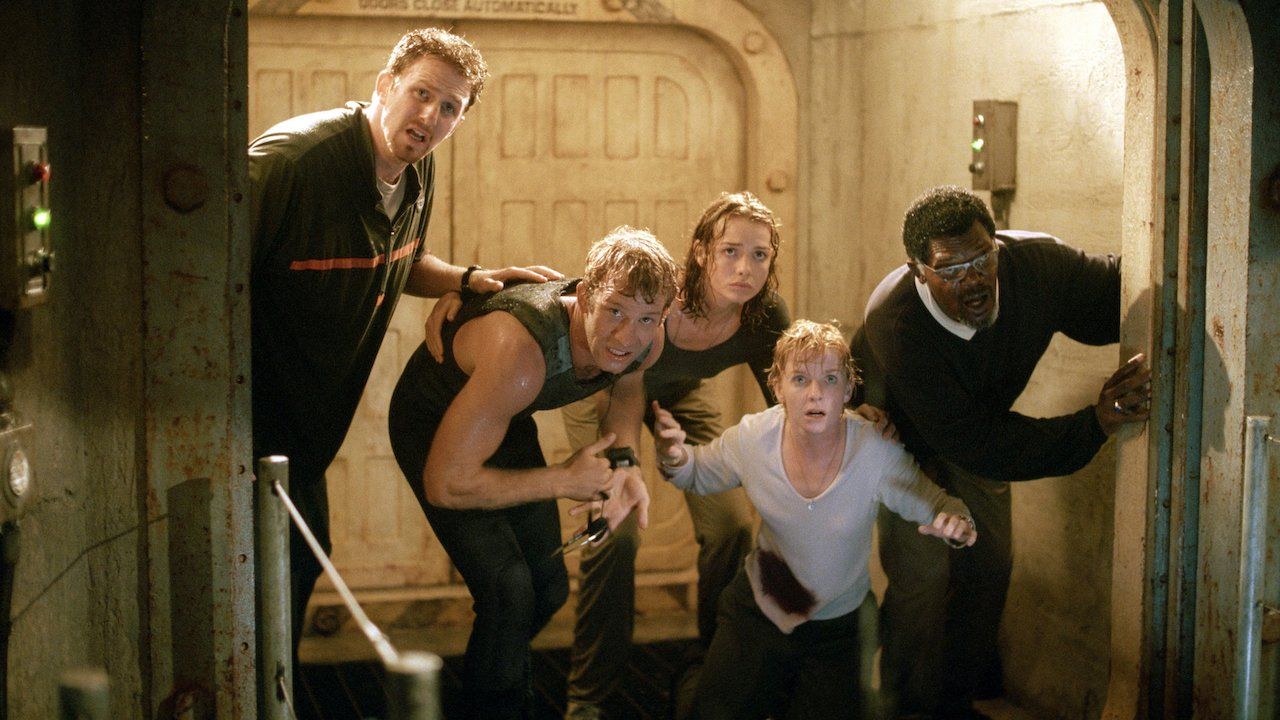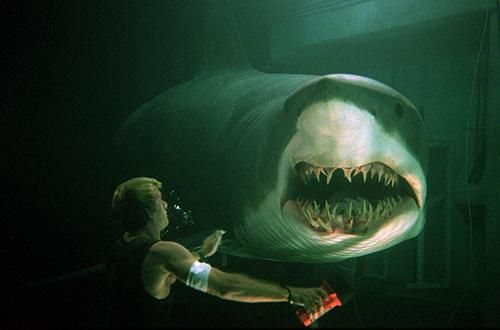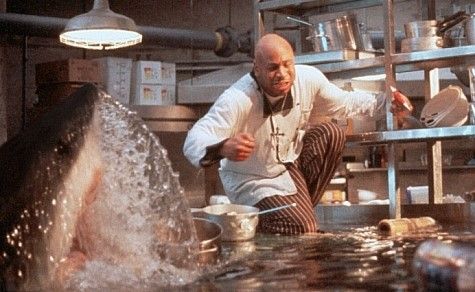Almost 50 years after Jaws hit the big screen and became a defining work of cinema, its influence on the art of filmmaking and popular culture has never declined. Many shark movies have come and gone in the decades since, but none has ever made the impact that Deep Blue Sea did. Following a successful run at the box office, it grew in popularity with home video audiences, to the point that it became something of a cult movie. While at a very different end of the shark movie spectrum than Jaws, it fit perfectly into the action/disaster cinema landscape of the late ‘90s, proving itself as wildly enjoyable popcorn entertainment, and ultimately, the "other" shark movie.
The very premise of Deep Blue Sea demonstrates its lovingly B-movie feel: a group of scientists working in an underwater lab have genetically engineered super-brained sharks in order to use their cerebral tissue as a cure for Alzheimer’s. But in order to do so, they have violated a few ethical codes of conduct, and “as a side effect the sharks got smarter!” Where Jaws was a simple man vs. beast story set in the real world, Deep Blue Sea leans fully into weird science, logical inconsistency and straight-up cheese. And every moment of it is unprecedentedly brilliant.

Saffron Burrows is Dr. Susan McAlester, a somber scientist whose personal experience with Alzheimer’s drives her to succeed by any means necessary. She is assisted by the reckless Dr. Jim Whitlock (Stellan Skarsgård), chirpy marine biologist Janice (Jacqueline McKenzie) and goofy engineer Scoggins (Michael Rapaport). Carter Blake (Thomas Jane) is the rugged blond muscleman with a shady past whose job is to wrangle the sharks and be the obvious hero of the story. Samuel L. Jackson is Russell Franklin, a financial backer of the project who has come to see where his money is going, and LL Cool J plays cook Preacher, because it was the ‘90s, so they needed a popular rapper to bring in the young crowd and contribute a song for the credits sequence.
Renny Harlin helmed the movie at an interesting point in his career. To this day, he has sustained a steady reputation as a pretty hit-and-miss director, with no fewer than six Razzie nominations. When Deep Blue Sea came around, he ventured on with his characteristic optimism and confidence in his work, going so far as to promise the audience would not be able to tell the difference between the real sharks and the CGI ones (don’t snigger!). While his direction is sharp and delivers a very good-looking movie, bad CGI sharks aside, his inherently campy style is the accidental savior of the picture.

Deep Blue Sea masquerades as a serious movie, but its tongue is planted firmly in its cheek. LL Cool J’s role in the first half almost constitutes a sitcom, in which he potters around the kitchen, whipping eggs and being sassed by his talking parrot. Nothing eases the mood of an action movie quite like a green bird calling LL Cool J a dickhead. Similarly, Michael Rapaport is there to be the goofy sidekick who makes fish puns and quips about a recently-deceased woman’s vibrator. All the best character tropes of the late ‘90s are embodied, which might lead the audience to believe that the movie would take them on a fairly conventional and predictable journey. But this is where Deep Blue Sea manages to distinguish itself.
One of the big talking points upon Deep Blue Sea’s release was the surprising turns of the plot — or more specifically, who dies and how. Samuel L. Jackson was unquestionably the star of the show with the most audience pull, and his character’s background as the hardened survivor of an avalanche cements him as a strong figure who is destined to survive this ordeal too. So when, in the middle of an epic morale-raising speech, he is suddenly attacked from behind and eaten by a shark, the rug is pulled from under the audience. Dr. Susan, meanwhile, would conventionally live and become the love interest of Carter. When test audiences protested this original ending, Harlin cleverly listened to feedback, and rewrote it. She is, after all, the real villain of the story, and therefore is gobbled up in the closing minutes, delivering a satisfying and thoroughly unexpected conclusion to her unreformed character.
Goofy dialogue and annoying talking parrots are only part of the cheesiness that really gives the movie its heart. The absolutely shameless B-movie science of Deep Blue Sea is so stupid, it’s endearing. On the larger scale, an obvious logical issue presents itself: just because a shark is smart or has an enlarged brain, does not mean it understands how physics works. Any brain needs to learn information in order to know it, and supersharks are no exception. So it seems pretty far-fetched that these lab-grown sharks understand who these people are or what has been done to them, let alone feel persecuted and decide to exact revenge. On the smaller scale of silly science, Dr. Susan drops raw shark brain juice onto raw human brain tissue, and it causes electrical sparks; water pressure operates on a time delay, so characters have enough time to escape. It is all so ridiculous that the audience can’t help but switch off and enjoy.

As silly as the story and tone can get at times, the movie doesn’t lose its focus on delivering the thrills. In typical late ‘90s fashion, it is action-heavy, and paces its sequences well to build suspense and get the most out of its climaxes. There are moments of misdirection from which unexpected surprises burst, such as the infamous demise of Stellan Skarsgård’s character, while other sequences take on a slow creeping menace as prelude to thrashing action. The vast, metallic confines of the sea lab and the use of blue and orange color palettes create a cold, clinical atmosphere where danger seems imminent. Strong production design and musical scoring play key parts in building an atmosphere of foreboding.
If Deep Blue Sea learned anything from Jaws, it was that music is more than background noise.Trevor Rabin’s tremendously evocative score understands the complexities of framing a scene with music. It has its own chillingly simple shark theme that uses a more conventional horror-style string arrangement as opposed to John Williams’ low woodwind, a creeping variation of which is used to imply the presence of the creatures among the vast dark water. Death scenes and dramatic climaxes are enhanced with choral accompaniment, which brings an almost hysterical human element to the horror. Where a final orchestral piece from Rabin might serve better dramatically, it was still the ‘90s, so instead LL Cool J plays out the show with a hip-hop number that goes "Deepest, bluest, my hat is like a shark’s fin." Fans still puzzle over the meaning of those lyrics to this day.
Deep Blue Sea is so archetypal of its time. Jurassic Park had kicked off a renewed trend for action movies that focused on man’s struggles against nature, the threats of which ranged from aliens and crocodiles to twisters and volcanoes. Posters for such movies typically used shadowy blues or reds, close-ups of characters looking pensive, and a hint of the lurking threat, be it explosions, water or an animal’s jaws. Deep Blue Sea made the interesting choice of keeping its star Jackson off of the posters, instead displaying the largely-unknown Burrows in an unzipped wetsuit, but otherwise it fit the mold of its contemporaries.
Computer generated animation had developed to the point that it was more affordable and practical to implement, making such techniques something of a staple of the era. This is not to say that the effects aged well, or even looked good on arrival, but they were being used on a wider scale, and as such, movies got more ambitious with what they could achieve onscreen. Beyond the sharks themselves, this enabled Deep Blue Sea to create a sense of vastness and isolation, with a fluidity of motion that demonstrates the parameters of its world. Even in enclosed spaces like a kitchen, or more specifically an oven, the endless water around them and dimensions captured on camera build a perilous atmosphere.

As ever, Renny Harlin set out to make a serious picture. With his trademark quixotism, he cited The Shining and The Exorcist as benchmarks for his shark movie, very much aspiring to horror. It is perhaps not surprising then that Deep Blue Sea would take on the tropes of millennial horror, such as jump scares serving as preludes to real attacks, goofy Friends-like characterization, and comedic relief in the form of a popular rapper (see Ice Cube in Anaconda and Busta Rhymes in Halloween: Resurrection). A pleasant side effect of Harlin’s overconfidence is a real sincerity; his work always seems to accidentally spill over into stupidity, kept anchored only by how seriously it takes itself. It is perhaps this artistic conviction that draws the line between Deep Blue Sea and Sharknado.
The SiFi era of the 2000s would bring a new identity to the shark movie, characterized by dismally subpar CGI, small budgets and a TV movie format. While sharks mostly became the territory of low-budget B-movie schlock, larger scale attempts at the subgenre periodically achieved theatrical releases, such as The Shallows and The Meg, neither of which made much of a lasting impact. The bombastic disaster cinema landscape of the late 1990s afforded Deep Blue Sea the perfect environment to be the long-awaited next blockbuster shark movie. Alongside the likes of Roland Emerich’s Independence Day and Godzilla, both of which did well at the box office without needing to offer an intellectually stimulating viewing experience, it made its mark within the safe confines of a proven trend and embodied everything people wanted out of a movie back then. It showed that the next big shark movie didn’t have to be another Jaws.
"Movies" - Google News
March 21, 2022 at 01:00AM
https://ift.tt/ZGl3A1e
How Deep Blue Sea Put the Bite Back in Shark Movies - Collider
"Movies" - Google News
https://ift.tt/ofq8x2l
Bagikan Berita Ini















0 Response to "How Deep Blue Sea Put the Bite Back in Shark Movies - Collider"
Post a Comment